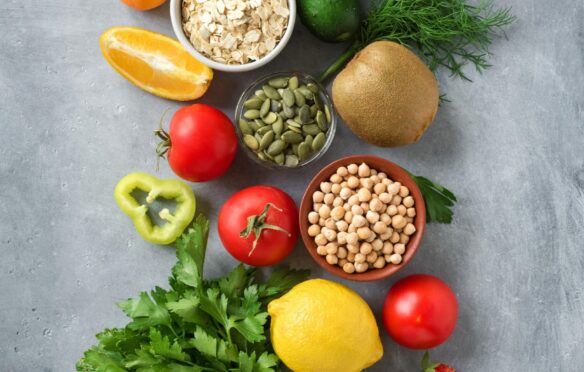
Eating more of some foods and less of others can help reduce your carbon footprint.
If you want to reduce your personal impact on the environment, you might think going increasingly vegetarian or vegan is the obvious answer in terms of diet.
However, ditching meat in favour of greenhouse-grown vegetables flown thousands of miles to reach your local supermarket might actually increase your carbon footprint.
When it comes to sustainable food and drink choices, there are lots of factors to consider, which is why some people choose to adopt a Climatarian diet, choosing lower-carbon options as much as possible.
“The intention of the Climatarian diet is to reduce our carbon footprint by making environmentally friendly choices with regards to food,” says Dr Alona Pulde of Lifesum, a nutrition app which has created a seven-day meal plan for eco-conscious consumers.
While some people choose to cut out meat completely, others don’t. The main goal of the diet, says Pulde, is to “eat more plant foods while limiting or eliminating animal products.”
“Plant foods, in general, have a lower carbon footprint than animal foods, with fruits and vegetables being particularly low,” she adds.
A Climatarian diet isn’t just about what you eat, it’s about how you shop and cook as well.
Pulde adds: “Buy just what you need to avoid food waste, and fill your freezer with leftovers to help reduce food waste and support healthy eating when you don’t feel like cooking.”
Flexitarian, climatarian, reducetarian – whatever the term – it simply means making smart food choices that are less harmful to the environment.
Professor Mark Maslin, a climate-change scientist at University College London and author of How To Save Our Planet, says a plant-based diet can literally help to save our planet. “By switching from a Western standard meat-based diet to a Climatarian diet, you can reduce your CO2 by 1.5 tonnes annually,” he said.
Not only is it good for the planet, reducing your meat consumption has a host of health benefits, too.
“Meat, especially highly processed meat, has been linked to heart disease, high blood pressure, gastrointestinal disorders and certain cancers,” says Pulde.
“A Climatarian diet focused on whole plant-based foods, has been shown to reduce the risk of diabetes, high blood pressure, heart disease, autoimmune diseases and obesity, while increasing overall vitality, mental health and longevity.”
Climatarian do’s and dont’s
Do eat more lentils and beans
As the tongue-in-cheek saying goes, beans really are good for your heart, especially if you use them as a meat alternative in things like chilli or pasta sauces. Replacing beef with lentils and beans could get us up to 74% closer to meeting our carbon emissions targets.
“This doesn’t have to happen every day for those that want to keep meat in their diet,” says Pulde. “You can try meatless Mondays, meatless breakfast and lunches, or meatless weekdays among others.”
Don’t buy palm oil products
The production of palm oil, which can be found in things like bread, biscuits, crisps and ice cream, contributes to deforestation, soil erosion, and natural habitat destruction, as well as higher carbon emissions. Look for ‘Palm oil free’ labels on packaging.
Do get the kids involved
“Climatarian diets rich in whole-plant based foods are abundant in the vitamins, minerals, antioxidants, and phytochemicals our bodies, including those of children, need to thrive,” says Pulde. But, she advises: “If you are choosing to go 100% plant based, children and adults need to supplement with vitamin B12.”
Do buy local and seasonal fruits and veggies
Salad or soup ingredients should never have to take a long-haul flight – buying local and seasonal reduces the C02 emissions from processing, packaging and transportation.
Do consider your coffee consumption
Often overlooked by conscious consumers, increased demand for coffee has resulted in production that contributes to deforestation, heavy water usage, pollution of waterways and natural habitat destruction. A crop of new sustainable brands such as Yallah Coffee and Chimney Fire Coffee are boosting their brews with strong eco credentials.
Do opt for whole grains
Whole grain products like pasta, brown rice and wheat require less processing and with their lower GI (glycaemic index) rating – meaning they release energy more slowly – they are
better nutritionally.
Do stock up on nuts and seeds
Great for snacking or adding to smoothies or overnight oats, nuts and seeds are a great source of protein. The most eco-friendly varieties include peanuts, hazelnuts, sunflower seeds, watermelon seeds and pumpkin seeds.
Don’t eat farmed fish
Following a pescatarian diet isn’t necessarily better for the environment. Farmed fish come with their own issues, including their faeces contributing to water pollution.
Do swap beef for chicken
If you don’t want to cut out meat completely, chicken is the least carbon-intensive option. Compared to beef, switching to chicken can decrease your carbon footprint by nearly half.
Do limit your sugar intake
Not only is excessive sugar consumption bad for your health, it’s bad for the planet, too. Sugar production can contribute to deforestation and is water intensive, which can lead to soil erosion.

Enjoy the convenience of having The Sunday Post delivered as a digital ePaper straight to your smartphone, tablet or computer.
Subscribe for only £5.49 a month and enjoy all the benefits of the printed paper as a digital replica.
Subscribe